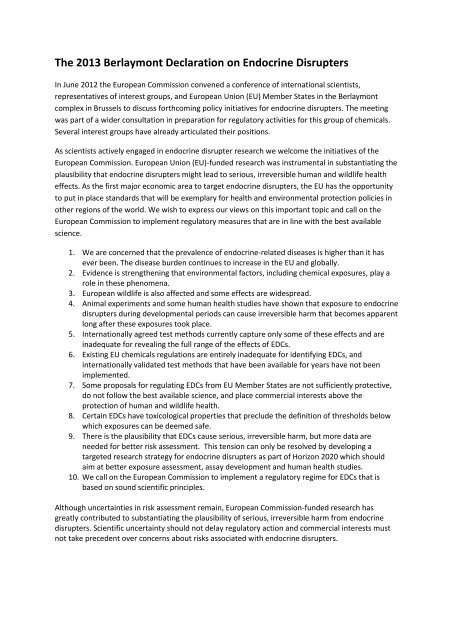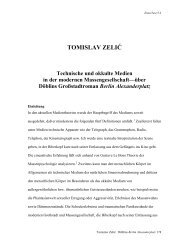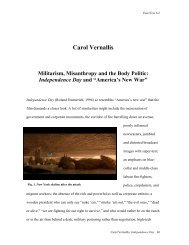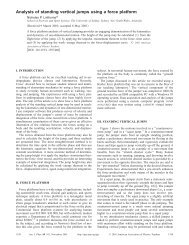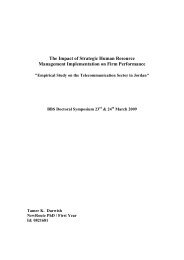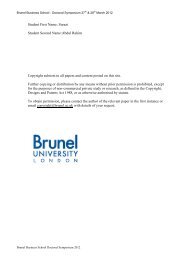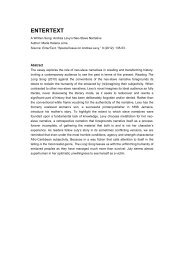The 2013 Berlaymont Declaration on Endocrine ... - Brunel University
The 2013 Berlaymont Declaration on Endocrine ... - Brunel University
The 2013 Berlaymont Declaration on Endocrine ... - Brunel University
You also want an ePaper? Increase the reach of your titles
YUMPU automatically turns print PDFs into web optimized ePapers that Google loves.
<str<strong>on</strong>g>The</str<strong>on</strong>g> <str<strong>on</strong>g>2013</str<strong>on</strong>g> <str<strong>on</strong>g>Berlaym<strong>on</strong>t</str<strong>on</strong>g> <str<strong>on</strong>g>Declarati<strong>on</strong></str<strong>on</strong>g> <strong>on</strong> <strong>Endocrine</strong> Disrupters<br />
In June 2012 the European Commissi<strong>on</strong> c<strong>on</strong>vened a c<strong>on</strong>ference of internati<strong>on</strong>al scientists,<br />
representatives of interest groups, and European Uni<strong>on</strong> (EU) Member States in the <str<strong>on</strong>g>Berlaym<strong>on</strong>t</str<strong>on</strong>g><br />
complex in Brussels to discuss forthcoming policy initiatives for endocrine disrupters. <str<strong>on</strong>g>The</str<strong>on</strong>g> meeting<br />
was part of a wider c<strong>on</strong>sultati<strong>on</strong> in preparati<strong>on</strong> for regulatory activities for this group of chemicals.<br />
Several interest groups have already articulated their positi<strong>on</strong>s.<br />
As scientists actively engaged in endocrine disrupter research we welcome the initiatives of the<br />
European Commissi<strong>on</strong>. European Uni<strong>on</strong> (EU)-funded research was instrumental in substantiating the<br />
plausibility that endocrine disrupters might lead to serious, irreversible human and wildlife health<br />
effects. As the first major ec<strong>on</strong>omic area to target endocrine disrupters, the EU has the opportunity<br />
to put in place standards that will be exemplary for health and envir<strong>on</strong>mental protecti<strong>on</strong> policies in<br />
other regi<strong>on</strong>s of the world. We wish to express our views <strong>on</strong> this important topic and call <strong>on</strong> the<br />
European Commissi<strong>on</strong> to implement regulatory measures that are in line with the best available<br />
science.<br />
1. We are c<strong>on</strong>cerned that the prevalence of endocrine-related diseases is higher than it has<br />
ever been. <str<strong>on</strong>g>The</str<strong>on</strong>g> disease burden c<strong>on</strong>tinues to increase in the EU and globally.<br />
2. Evidence is strengthening that envir<strong>on</strong>mental factors, including chemical exposures, play a<br />
role in these phenomena.<br />
3. European wildlife is also affected and some effects are widespread.<br />
4. Animal experiments and some human health studies have shown that exposure to endocrine<br />
disrupters during developmental periods can cause irreversible harm that becomes apparent<br />
l<strong>on</strong>g after these exposures took place.<br />
5. Internati<strong>on</strong>ally agreed test methods currently capture <strong>on</strong>ly some of these effects and are<br />
inadequate for revealing the full range of the effects of EDCs.<br />
6. Existing EU chemicals regulati<strong>on</strong>s are entirely inadequate for identifying EDCs, and<br />
internati<strong>on</strong>ally validated test methods that have been available for years have not been<br />
implemented.<br />
7. Some proposals for regulating EDCs from EU Member States are not sufficiently protective,<br />
do not follow the best available science, and place commercial interests above the<br />
protecti<strong>on</strong> of human and wildlife health.<br />
8. Certain EDCs have toxicological properties that preclude the definiti<strong>on</strong> of thresholds below<br />
which exposures can be deemed safe.<br />
9. <str<strong>on</strong>g>The</str<strong>on</strong>g>re is the plausibility that EDCs cause serious, irreversible harm, but more data are<br />
needed for better risk assessment. This tensi<strong>on</strong> can <strong>on</strong>ly be resolved by developing a<br />
targeted research strategy for endocrine disrupters as part of Horiz<strong>on</strong> 2020 which should<br />
aim at better exposure assessment, assay development and human health studies.<br />
10. We call <strong>on</strong> the European Commissi<strong>on</strong> to implement a regulatory regime for EDCs that is<br />
based <strong>on</strong> sound scientific principles.<br />
Although uncertainties in risk assessment remain, European Commissi<strong>on</strong>-funded research has<br />
greatly c<strong>on</strong>tributed to substantiating the plausibility of serious, irreversible harm from endocrine<br />
disrupters. Scientific uncertainty should not delay regulatory acti<strong>on</strong> and commercial interests must<br />
not take precedent over c<strong>on</strong>cerns about risks associated with endocrine disrupters.
Our positi<strong>on</strong> is based <strong>on</strong> the following scientific observati<strong>on</strong>s and research findings which have been<br />
laid out in more detail in recent reports from the European Envir<strong>on</strong>ment Agency, in a European<br />
Commissi<strong>on</strong> – funded report and an assessment c<strong>on</strong>ducted under the auspices of the World Health<br />
Organisati<strong>on</strong> and the United Nati<strong>on</strong>s Envir<strong>on</strong>mental Programme 1 :<br />
1. We are c<strong>on</strong>cerned that the prevalence of endocrine-related diseases c<strong>on</strong>tinues to increase<br />
in the European Uni<strong>on</strong> and globally. This is not well recognised by the public and largely<br />
ignored by policy makers in EU Member States.<br />
In some EU Member States large proporti<strong>on</strong>s of young men have semen quality so<br />
poor that it will seriously affect their chances of siring children. At the same time,<br />
c<strong>on</strong>genital malformati<strong>on</strong>s such as hypospadias (malformati<strong>on</strong>s of the penis) and<br />
n<strong>on</strong>-descending testes are increasing or levelling off at unfavourably high levels.<br />
Many Member States have not given attenti<strong>on</strong> to this issue and have not initiated<br />
relevant research studies.<br />
<str<strong>on</strong>g>The</str<strong>on</strong>g>re is a dramatic rise in breast cancer in Eastern and Southern European EU<br />
Member States. In West European countries, where breast cancer is more prevalent,<br />
incidences increase more slowly or are levelling off at rates much higher than 30<br />
years ago.<br />
With the excepti<strong>on</strong> of high prevalence countries such as <str<strong>on</strong>g>The</str<strong>on</strong>g> Netherlands and<br />
Austria, all EU countries are experiencing str<strong>on</strong>g rises in prostate cancer. Similar<br />
trends exist for other horm<strong>on</strong>al cancers, including those of the testes, endometrium,<br />
ovaries and thyroid.<br />
Neurobehavioural disorders, and thyroid diseases and disorders affecting brain<br />
development, represent a high and increasing pediatric disease burden in countries<br />
where these disease trends have been followed.<br />
<str<strong>on</strong>g>The</str<strong>on</strong>g> prevalence of obesity and its comorbidity factors, type 2 diabetes and metabolic<br />
syndrome, have increased dramatically in almost all EU Member States.<br />
2. We recognise that multiple causes underlie these trends, including nutriti<strong>on</strong> or maternal and<br />
paternal age. However, because of the rapid pace with which these increases have occurred,<br />
explanati<strong>on</strong>s solely in terms of genetics, better diagnosis or life style lack plausibility.<br />
Evidence is strengthening that envir<strong>on</strong>mental factors, including chemical exposures, also<br />
play a role in these disease trends, but the chemicals involved are difficult to pinpoint. <str<strong>on</strong>g>The</str<strong>on</strong>g><br />
full range of c<strong>on</strong>tributing chemical exposures is not known, but some associati<strong>on</strong>s have<br />
come to light:<br />
1 European Envir<strong>on</strong>ment Agency (2012) <str<strong>on</strong>g>The</str<strong>on</strong>g> impacts of endocrine disrupters <strong>on</strong> wildlife, people and their<br />
envir<strong>on</strong>ment – the Weybridge +15 report. http://www.eea.europa.eu/publicati<strong>on</strong>s/the-impacts-of-endocrinedisrupters<br />
Kortenkamp A, Martin, O, Faust M, Evans R, McKinlay R, Ort<strong>on</strong> F, Rosivatz E (2012) State of the art assessment<br />
of endocrine disrupters. DG Envir<strong>on</strong>ment project c<strong>on</strong>tract number 070307/2009/550687/SER/D3.<br />
http://ec.europa.eu/envir<strong>on</strong>ment/endocrine/documents/4_SOTA%20EDC%20Final%20Report%20V3%206%20<br />
Feb%2012.pdf<br />
UNEP WHO (<str<strong>on</strong>g>2013</str<strong>on</strong>g>) State of the science of endocrine disrupting chemicals – 2012 (Editors: Bergman A, Heindel<br />
JJ, Jobling S, Kidd KA, Zoeller RT.<br />
http://www.unep.org/hazardoussubstances/Portals/9/EDC/StateOfEDCScience.pdf
Testis maldescent in young boys has been linked with exposure to DES during<br />
pregnancy, certain polybrominated diphenyl ethers used as flame retardants, and<br />
occupati<strong>on</strong>al pesticide exposure.<br />
High exposures to polychlorinated dioxins, certain polychlorinated biphenyls (PCBs)<br />
(in women who lack some detoxifying enzymes) and DDE (in early life) have been<br />
shown to be risk factors in breast cancer.<br />
Prostate cancer risks were in some studies related to occupati<strong>on</strong>al exposures to<br />
pesticides (of an unidentified nature), to certain PCBs and to arsenic.<br />
Developmental neurotoxicity with negative impacts <strong>on</strong> brain development has been<br />
linked with lead, methylmercury and PCBs.<br />
3. <str<strong>on</strong>g>The</str<strong>on</strong>g>re is a worldwide decline in biodiversity of wildlife species and it is plausible that<br />
chemical exposures are playing a role in this. Wildlife populati<strong>on</strong>s have been affected by<br />
endocrine disrupters, with adverse effects <strong>on</strong> growth and reproducti<strong>on</strong>. Some of these<br />
effects are widespread.<br />
Seal col<strong>on</strong>ies in heavily polluted areas of the Baltic and North Seas have been<br />
affected by female reproductive pathologies, b<strong>on</strong>e damage and reproductive failure<br />
which correlate with exposure to persistent organic pollutants (POPs), especially<br />
PCBs. C<strong>on</strong>comitant with a decline in PCB exposures the populati<strong>on</strong>s are recovering.<br />
Increased POP burdens in lesser black-backed gulls in Norway correlated with<br />
skewed sex ratios in favour of female chicks. When gulls are in poor c<strong>on</strong>diti<strong>on</strong> they<br />
hatch more female chicks.<br />
A large number of amphibians are highly threatened with extincti<strong>on</strong>, and there are<br />
indicati<strong>on</strong>s of an involvement of endocrine disrupters.<br />
Especially in the UK, male fish have been widely affected by increased levels of the<br />
egg yolk protein vitellogenin and by intersex. This is attributed to exposure to<br />
sewage effluents which c<strong>on</strong>tain estrogenic and anti-androgenic chemicals.<br />
<str<strong>on</strong>g>The</str<strong>on</strong>g> use of tributyltin and triphenyltin as anti-foulants <strong>on</strong> ship hulls have triggered<br />
the collapse of commercially important oyster populati<strong>on</strong>s and snail species.<br />
Reducti<strong>on</strong>s in exposure have led to a recovery of these populati<strong>on</strong>s.<br />
4. Extensive laboratory studies and some human health studies have shown that interference<br />
with horm<strong>on</strong>e acti<strong>on</strong> during critical periods of development can cause irreversible and<br />
delayed effects that do not become evident until later in life. <str<strong>on</strong>g>The</str<strong>on</strong>g>se insights highlight the<br />
need to focus <strong>on</strong> exposures during windows of heightened sensitivity coupled with the<br />
evaluati<strong>on</strong> of the full range of adverse effects later in life. <str<strong>on</strong>g>The</str<strong>on</strong>g>re is the danger that important<br />
hazards are overlooked if testing is c<strong>on</strong>ducted outside these periods.<br />
In rodent experiments, certain dicarboximide, imidazole and azole pesticides can<br />
interfere with androgen acti<strong>on</strong> during fetal life, when male development is<br />
programmed. Some of the effects <strong>on</strong>ly become apparent in adult life and are<br />
irreversible; these include malformati<strong>on</strong>s of reproductive organs. Exposure to these<br />
chemicals in adult life does not induce such effects.<br />
Epidemiological studies show that exposure to dioxin (TCDD) around the time of<br />
birth has a negative impact <strong>on</strong> semen quality. With exposure during puberty, the
opposite effect occurs, while exposure during adulthood has no influence <strong>on</strong> semen<br />
quality.<br />
Rodents exposed to estradiol and estrogenic chemicals around the time of birth<br />
suffer interferences with a brain signalling system that sets the timing of puberty.<br />
Exposure during other life stages does not produce this effect.<br />
<str<strong>on</strong>g>The</str<strong>on</strong>g> development of the female reproductive system is programmed in fetal life and<br />
can be disrupted at this stage by signalling from chemicals such as DES, with<br />
malformati<strong>on</strong>s being <strong>on</strong>e c<strong>on</strong>sequence.<br />
<str<strong>on</strong>g>The</str<strong>on</strong>g> acti<strong>on</strong> of thyroid horm<strong>on</strong>es during development in the womb is essential for<br />
many developmental landmarks, including the development of the brain and the<br />
neuro-endocrine system. Disrupti<strong>on</strong> of thyroid acti<strong>on</strong> by chemical exposures at this<br />
stage of development can have detrimental and irreversible effects.<br />
5. Internati<strong>on</strong>ally agreed and validated test methods (OECD) for the identificati<strong>on</strong> of endocrine<br />
disrupters capture <strong>on</strong>ly a segment of the known range of endocrine disrupting effects,<br />
mainly focused <strong>on</strong> estrogenicity, (anti)androgenicity and thyroid disrupti<strong>on</strong> (“EAT”). Other<br />
aspects of the endocrine system(s) are not c<strong>on</strong>sidered, although it is clear that the<br />
complexity of endocrine systems cannot be reduced to EAT. This introduces c<strong>on</strong>siderable<br />
uncertainties, and the likelihood of overlooking harmful effects in humans and wildlife is<br />
high.<br />
For many endocrine disrupting effects, internati<strong>on</strong>ally agreed and validated test<br />
methods do not exist, although scientific tools and laboratory methods are available.<br />
For a large range of human health effects, viable laboratory models are missing<br />
altogether. This seriously hampers progress with understanding the full extent of<br />
risks.<br />
6. Important pieces of EU chemicals regulati<strong>on</strong> are entirely inadequate for capturing endocrine<br />
disrupting effects. Even internati<strong>on</strong>ally validated and well established test systems that have<br />
been available for over a decade have not been implemented. Any measures aimed at<br />
protecting humans and wildlife from endocrine disrupters will be ineffective if testing<br />
requirements are not updated to incorporate endocrine disrupter testing.<br />
<str<strong>on</strong>g>The</str<strong>on</strong>g> current testing and informati<strong>on</strong> requirements defined for industrial and<br />
commercial chemicals (REACH) and for plant protecti<strong>on</strong> products (PPPR) are not<br />
geared towards the identificati<strong>on</strong> of endocrine disrupting chemicals. <str<strong>on</strong>g>The</str<strong>on</strong>g> relevant<br />
regulati<strong>on</strong>s and directives (e.g. 544/2011 and 545/2011) require urgent updates to<br />
include the best available science.<br />
Testing with the most sensitive and appropriate endpoints and with exposure<br />
regimens that cover periods of heightened sensitivity during development is<br />
currently not mandatory. As a result, many endocrine disrupting chemicals are not<br />
identified.<br />
7. Proposals for the regulati<strong>on</strong> of endocrine disrupting pesticides from certain EU Member<br />
States do not follow scientifically sound principles and are not sufficiently protective. By<br />
regulating as few endocrine disrupters as possible they place commercial interests above the<br />
protecti<strong>on</strong> of human and wildlife health.
<str<strong>on</strong>g>The</str<strong>on</strong>g>se proposals focus <strong>on</strong> the use of potency-based cut-off values as the basis for<br />
classifying pesticides as endocrine disrupters. We are c<strong>on</strong>cerned that these values<br />
set the bar too high, with the serious possibility that hardly any substance will be<br />
classified as an endocrine disrupter in the regulatory sense, thus effectively<br />
undermining the intenti<strong>on</strong> of the legislati<strong>on</strong>.<br />
Given the likelihood of mixture effects from exposures to numerous EDCs with<br />
similar effect profiles, even EDCs c<strong>on</strong>sidered to be weakly potent are of c<strong>on</strong>cern<br />
because they may add to the combined effect.<br />
8. We are c<strong>on</strong>cerned that the discussi<strong>on</strong> about so-called low dose effects has paid too little<br />
attenti<strong>on</strong> to the possibility that many endocrine disrupters may act without thresholds<br />
because of pre-existing internal exposures to natural horm<strong>on</strong>es and, in the case of<br />
background exposures, to substances with similar effect profiles.<br />
In such situati<strong>on</strong>s, endocrine disrupters entering a biological system will add to the<br />
internal load, without having to overcome a dose threshold. This is particularly<br />
relevant to estrogenic agents and to chemicals with effects similar to dioxins.<br />
It is plausible that these types of endocrine disrupters will act independent of<br />
thresholds, as would be expected, e.g., for genotoxic carcinogens. This should be<br />
c<strong>on</strong>sidered during the <strong>on</strong>going REACH revisi<strong>on</strong>.<br />
9. In the foreseeable future, endocrine disrupter regulatory activities will have to cope with the<br />
tensi<strong>on</strong> between the plausibility of serious, irreversible damage and the delays in generating<br />
the data that are indispensable for comprehensive risk assessment. This tensi<strong>on</strong> can <strong>on</strong>ly be<br />
resolved by promoting further research into endocrine disrupters. We call <strong>on</strong> the European<br />
Commissi<strong>on</strong> to implement in Horiz<strong>on</strong> 2020 a targeted endocrine disrupter research<br />
programme, with a focus <strong>on</strong>:<br />
Exposure assessments and the identificati<strong>on</strong> of substances with endocrine disrupting<br />
properties: <str<strong>on</strong>g>The</str<strong>on</strong>g>re is a serious mismatch between substances that are wellresearched<br />
and the vast numbers of chemicals in commercial use, for which<br />
endocrine disrupting properties have not been investigated very well, if at all.<br />
Despite years of endocrine disrupter research, the full spectrum of chemicals that<br />
might c<strong>on</strong>tribute to endocrine-related diseases and wildlife effects is unknown. This<br />
deadlock can <strong>on</strong>ly be broken by dedicated research strategies that harness the<br />
recent advances in unbiased chemical analytical technologies.<br />
Assay development: Important aspects of endocrine disrupti<strong>on</strong> cannot be<br />
investigated, because suitable laboratory models and assessment criteria are<br />
missing altogether. This is especially relevant in the areas of horm<strong>on</strong>al<br />
carcinogenesis, female reproductive health, metabolic syndrome, obesity, and<br />
neuro-endocrine effects. Assays and assessment methodologies for many wildlife<br />
phyla and taxa are absent and fundamental research <strong>on</strong> the endocrinology of many<br />
invertebrate taxa is necessary. C<strong>on</strong>certed research and development efforts are<br />
urgently needed to fill these gaps.<br />
Research in support of better human health studies: Due to the lack of relevant<br />
laboratory models for numerous health effects, endocrine disrupter research will<br />
have to depend <strong>on</strong> epidemiological studies in the foreseeable future. But human
epidemiology faces c<strong>on</strong>siderable difficulties in recognising the health risks that<br />
might stem from endocrine disrupters. Complicati<strong>on</strong>s arise mainly from the time lag<br />
between disease causati<strong>on</strong> and the diagnosis of health effects, the absence of<br />
methodologies for dealing with exposures to multiple chemicals, and the lack of<br />
informati<strong>on</strong> about the full spectrum of chemicals that might c<strong>on</strong>tribute to risks. <str<strong>on</strong>g>The</str<strong>on</strong>g><br />
tissues collected in many existing cohorts are not geared towards ascertaining<br />
exposures to relevant endocrine disrupters, and towards dealing with exposures<br />
during critical life stages. This can <strong>on</strong>ly be resolved by allocating resources to set up<br />
new cohorts, with carefully planned chemical analytical strategies and clear<br />
hypotheses.<br />
10. We call <strong>on</strong> the European Commissi<strong>on</strong> to implement a regulatory regime for endocrine<br />
disrupters that is based <strong>on</strong> sound scientific principles. Although uncertainties remain,<br />
European Commissi<strong>on</strong>-funded research has greatly c<strong>on</strong>tributed to substantiating the<br />
plausibility of serious, irreversible harm stemming from endocrine disrupters. Scientific<br />
uncertainty should therefore not delay regulatory acti<strong>on</strong>. Commercial interests must not<br />
take precedent over c<strong>on</strong>cerns about risks associated with endocrine disrupters. More<br />
specifically, we call <strong>on</strong> the European Commissi<strong>on</strong> to:<br />
Signatories:<br />
Implement a regulatory regime that classifies endocrine disrupters by using weightof-evidence<br />
approaches. Schemes based <strong>on</strong> cut-off values for potency are<br />
scientifically indefensible and are too formulaic to accommodate the subtleties<br />
needed for scientifically sound judgements.<br />
Update the testing requirements for chemical substances under REACH, PPPR and<br />
the Biocide Regulati<strong>on</strong> to include effects of endocrine disrupters. <strong>Endocrine</strong><br />
disrupter regulati<strong>on</strong> will fail if these steps are not taken.<br />
Develop a targeted research strategy for endocrine disrupters as part of Horiz<strong>on</strong><br />
2020. This strategy should aim to fill the gaps left by previous efforts, namely in<br />
terms of exposure assessment, assay development and better human health studies.<br />
Aennes Abbas Johann Wolfgang Goethe <strong>University</strong>, Frankfurt, Germany<br />
Dr Lutz Ahrens Swedish Agricultural <strong>University</strong>, Uppsala, Sweden<br />
Dr Anna Maria Anderss<strong>on</strong> <strong>University</strong> Dept of Growth and Reproducti<strong>on</strong>, Rigshospitalet,<br />
Copenhagen, Denmark<br />
Prof Patrik Anderss<strong>on</strong> Umea <strong>University</strong>, Sweden<br />
Dr Ricardo Barra <strong>University</strong> of C<strong>on</strong>cepci<strong>on</strong>, Chile<br />
Prof Bert van Bavel Orebro <strong>University</strong>, Sweden<br />
Dr Alice Baynes <strong>Brunel</strong> <strong>University</strong>, L<strong>on</strong>d<strong>on</strong>, United Kingdom<br />
Prof Georg Becher Norwegian Institute of Public Health, Oslo, Norway<br />
Prof Martin van den Berg Utrecht <strong>University</strong>, Utrecht, <str<strong>on</strong>g>The</str<strong>on</strong>g> Netherlands<br />
Prof Ake Bergman Stockholm <strong>University</strong>, Stockholm, Sweden<br />
Anna Ber<strong>on</strong>ius Karolinska Institute, Stockholm, Sweden<br />
Prof Bruce Blumberg <strong>University</strong> of California at Irvine, Irvine, USA<br />
Daniel Borg Karolinska Institute, Stockholm, Sweden
Prof Carl-Gustaf Bornehag Karlstad <strong>University</strong>, Karlstad, Sweden<br />
Prof Riana Bornman <strong>University</strong> of Pretoria, South Africa<br />
Dr Magnus Breitholz Stockholm <strong>University</strong>, Stockholm, Sweden<br />
Prof Alex Burdorf Erasmus Medical Centre, Rotterdam, <str<strong>on</strong>g>The</str<strong>on</strong>g> Netherlands<br />
Dr Miriam Diam<strong>on</strong>d Tor<strong>on</strong>to <strong>University</strong>, Canada<br />
Dr Marjorie van Duursen Utrecht <strong>University</strong>, Utrecht, <str<strong>on</strong>g>The</str<strong>on</strong>g> Netherlands<br />
Dr Sibylle Ermler <strong>Brunel</strong> <strong>University</strong>, L<strong>on</strong>d<strong>on</strong>, United Kingdom<br />
Dr Michael Faust F+B Envir<strong>on</strong>mental C<strong>on</strong>sulting, Bremen, Germany<br />
Dr Vincente Felipo Research Centre Principe Felipe, Valencia, Spain<br />
Dr Mariana Fernandez <strong>University</strong> of Granada, Granada, Spain<br />
Jane Firth LGC Standards, Teddingt<strong>on</strong>, United Kingdom<br />
Prof Bernd Fischer Martin Luther <strong>University</strong>, Halle, Germany<br />
Prof Paul Fowler <strong>University</strong> of Aberdeen, United Kingdom<br />
Dr Hanne Frederiksen <strong>University</strong> Dept of Growth and Reproducti<strong>on</strong>, Rigshospitalet,<br />
Copenhagen, Denmark<br />
Dr Heloise Frouin Fisheries and Oceans, Life Oceans Institute, Sidney, Canada<br />
David Gee Senior Advisor, European Envir<strong>on</strong>ment Agency, Copenhagen<br />
Prof Helen Håkanss<strong>on</strong> Karolinska Institute, Stockholm, Sweden<br />
Prof Ulla Hass Nati<strong>on</strong>al Food Institute, Danish Technical <strong>University</strong>,<br />
Copenhagen, Denmark<br />
Prof Elizabeth Hill <strong>University</strong> of Sussex, Bright<strong>on</strong>, United Kingdom<br />
Prof Taisen Iguchi Nati<strong>on</strong>al Institute for Basic Biology, Okazaki, Japan<br />
Prof Kristina Jakobss<strong>on</strong> Lund <strong>University</strong>, Sweden<br />
Prof Bernard Jegou INSERM, Rennes <strong>University</strong>, France<br />
Prof Susan Jobling <strong>Brunel</strong> <strong>University</strong>, L<strong>on</strong>d<strong>on</strong>, United Kingdom<br />
Prof Andrew Johns<strong>on</strong> Centre for Ecology and Hydrology, Wallingford, United<br />
Kingdom<br />
Dr Bernt J<strong>on</strong>es Swedish Agricultural <strong>University</strong>, Uppsala, Sweden<br />
Dr Mari<strong>on</strong> Junghans as a private pers<strong>on</strong><br />
Prof Anders Juul <strong>University</strong> Dept of Growth and Reproducti<strong>on</strong>, Rigshospitalet,<br />
Copenhagen, Denmark<br />
Prof Rakesh Kanda <strong>Brunel</strong> <strong>University</strong>, L<strong>on</strong>d<strong>on</strong>, United Kingdom<br />
Dr Ioanna Katsiadaki CEFAS Weymouth Laboratory, Weymouth, United Kingdom<br />
Prof Karen A Kidd <strong>University</strong> of New Brunswick, Canada<br />
Prof Thomas Kl<strong>on</strong>isch <strong>University</strong> of Manitoba, Winnipeg, Canada<br />
Prof Andreas Kortenkamp <strong>Brunel</strong> <strong>University</strong>, L<strong>on</strong>d<strong>on</strong>, United Kingdom<br />
Prof Vincent Laudet Ecole Normale Superieure, Ly<strong>on</strong>, France<br />
Prof Juliette Legler Free <strong>University</strong>, Amsterdam, <str<strong>on</strong>g>The</str<strong>on</strong>g> Netherlands<br />
Prof Walter Lichtensteiger GreenTox and <strong>University</strong> of Zurich, Switzerland<br />
Prof M<strong>on</strong>ica Lind Umea <strong>University</strong>, Umea, Sweden<br />
Dr Rainer Lohmann <strong>University</strong> of Rhode Island, Narragansett, USA<br />
Dr Mirek Machala Veterinary Research Institute, Brno, Czech Republic<br />
Dr Olwenn Martin <strong>Brunel</strong> <strong>University</strong>, L<strong>on</strong>d<strong>on</strong>, United Kingdom<br />
Dr. Piedad Martin-Olmedo Escuela Andaluza de Salud Pública, Granada, Spain<br />
Prof Jesus del Mazo Biological Research Centre (CSIC), Madrid, Spain
Prof Sverker Molander Chalmers <strong>University</strong>, Goeteborg, Sweden<br />
Dr Jane Muncke FP Forum, Zurich, Switzerland<br />
Prof Angel Nadal Miguel Hernanadez <strong>University</strong>, Elcha (Alicante), Spain<br />
Dr Christine Nellemann Head of Divisi<strong>on</strong>, Nati<strong>on</strong>al Food Institute, Danish Technical<br />
<strong>University</strong>, Copenhagen, Denmark<br />
Prof Leif Norrgren Swedish Agricultural <strong>University</strong>, Uppsala, Sweden<br />
Prof Nicolas Olea <strong>University</strong> of Granada, Spain<br />
Prof Agneta Oskarss<strong>on</strong> Swedish Agricultural <strong>University</strong>, Uppsala, Sweden<br />
Prof Roberta Pastorelli Pharmacology Research Institute, Mario Negri, Milan, Italy<br />
Prof Miquel Porta Aut<strong>on</strong>omous <strong>University</strong> of Barcel<strong>on</strong>a, Barcel<strong>on</strong>a, Spain<br />
Dr Tom Pottinger Centre for Ecology and Hydrology, Lancaster, United<br />
Kingdom<br />
Prof Anna Riquell Hydbom Lund <strong>University</strong>, Sweden<br />
Dr Per Roos Karolinska Institute, Stockholm, Sweden<br />
Prof Eric Ropstad Norwegian School of Veterinary Sciences, Oslo, Norway<br />
Dr Edwin Routledge <strong>Brunel</strong> <strong>University</strong>, L<strong>on</strong>d<strong>on</strong>, United Kingdom<br />
Prof Christina Ruden Stockholm <strong>University</strong>, Stockholm, Sweden<br />
Prof Yanling Qiu T<strong>on</strong>gji <strong>University</strong>, China<br />
Prof Margret Schlumpf GreenTox and <strong>University</strong> of Zurich, Switzerland<br />
Prof Heqing Shen Institute of Urban Envir<strong>on</strong>ment, Chinese Academy of<br />
Sciences, China<br />
Dr Elisabete Silva <strong>Brunel</strong> <strong>University</strong>, United Kingdom<br />
Prof Niels E Skakkebaek <strong>University</strong> Dept of Growth and Reproducti<strong>on</strong>, Rigshospitalet,<br />
Copenhagen, Denmark<br />
Prof Olle Sőder Karolinska Institute at Karolinska <strong>University</strong> Hospital,<br />
Stockholm, Sweden<br />
Prof Carlos S<strong>on</strong>nenschein Tufts <strong>University</strong>, Bost<strong>on</strong>, USA<br />
Prof Ana Soto Tufts <strong>University</strong>, Bost<strong>on</strong>, USA<br />
Dr Kugathas Subramaniam <strong>Brunel</strong> <strong>University</strong>, L<strong>on</strong>d<strong>on</strong>, United Kingdom<br />
Prof Shanna Swan School of Medicine at Mount Sinai, New York, USA<br />
Prof Margareta Tornqvist Stockholm <strong>University</strong>, Stockholm, Sweden<br />
Prof Jorma Toppari <strong>University</strong> of Turku, Finland<br />
Prof Charles Tyler <strong>University</strong> of Exeter, United Kingdom<br />
Prof Anne Marie Vinggaard Nati<strong>on</strong>al Food Institute, Danish Technical <strong>University</strong>,<br />
Copenhagen, Denmark<br />
Dr Martin Wagner Johann Wolfgang Goethe <strong>University</strong>, Frankfurt, Germany<br />
Prof Karin Wiberg Swedish Agricultural <strong>University</strong>, Uppsala, Sweden<br />
Prof Cynthia de Wit Stockholm <strong>University</strong>, Stockholm, Sweden<br />
Dr Leticia Yanez Estrada Medical Faculty, <strong>University</strong> of Mexico, Mexico<br />
Prof Daqiang Yiu T<strong>on</strong>gji <strong>University</strong>, China<br />
Prof R Thomas Zoeller <strong>University</strong> of Massachusetts, USA<br />
Affiliati<strong>on</strong>s are given for identificati<strong>on</strong> purposes <strong>on</strong>ly – all signatories have signed in a pers<strong>on</strong>al<br />
capacity


